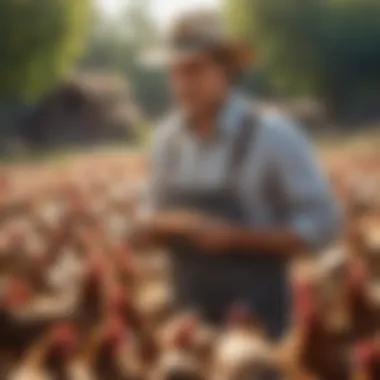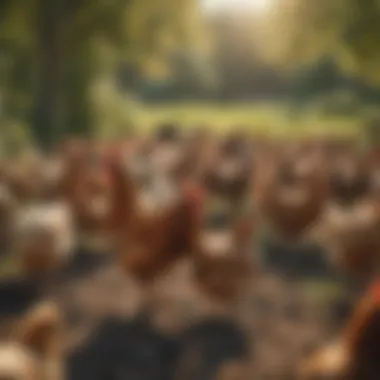Understanding Pastured Poultry: A Comprehensive Overview


Intro
The concept of pastured poultry is gaining traction in modern agriculture. This method not just enhances the welfare of the birds but also contributes to a more sustainable form of farming. Understanding the nuances of pastured poultry involves examining its benefits and the logistics involved in its implementation. In this article, we will delve into various aspects of pastured poultry, considering its relevance in the evolving landscape of agriculture and the role it plays in sustainable farming practices.
Latest Trends in Agriculture
Overview of Current Trends
Agricultural practices are undeniably shifting towards sustainability. One prominent trend is the increase in demand for humane and ethical treatment of animals. Pastured poultry meets this demand by allowing birds to engage in natural behaviors while foraging outdoors. This method not only nurtures healthier livestock but also builds a connection between consumers and the sources of their food.
Impact of Technology on Farming Practices
The integration of technology into farming has presented new opportunities for monitoring and managing pastured poultry systems. Tools such as GPS tracking and automated feeders enable farmers to oversee larger areas and ensure the welfare of their livestock effectively. This not only enhances productivity but also promotes environmental stewardship. Farmers are now able to employ apps and software to keep track of health metrics and production statistics in real-time, securing both efficiency and transparency in their operations.
Sustainable Practices: Towards a Greener Future
Importance of Sustainability in Agriculture
Sustainable agriculture is essential in addressing climate change, biodiversity loss, and resource depletion. Pastured poultry offers a model of how livestock can coexist with ecological systems. By rotating flocks in designated areas, soil health is improved through natural fertilization, and pest control is enhanced via natural predation.
Methods for Sustainable Farming
Integrating pastured poultry into existing agricultural systems requires understanding various methods that align with sustainable practices. Some of these methods include:
- Rotational grazing: This technique prevents overgrazing and encourages even manure distribution.
- Mixed farming systems: Combining pastured poultry with other livestock or crops can create a synergistic effect, reducing the need for synthetic fertilizers and pesticides.
- Community Supported Agriculture (CSA): Engaging with local communities can foster direct marketing opportunities while also enhancing community awareness about sustainable practices.
Challenges and Opportunities
While the benefits of pastured poultry are clear, there are challenges to consider. Weather conditions, land availability, and initial infrastructure costs can pose obstacles to farmers looking to adopt this practice. However, research and collaboration among agricultural communities continue to unlock innovative solutions.
"Pastured poultry represents not just a method of farming, but a commitment to sustainable practices that benefit both the environment and public health."
As understanding deepens, the opportunities for growth and development in this niche will likely expand. Equipped with knowledge and insight, farmers and enthusiasts can make informed decisions regarding the integration of pastured poultry in their operations.
Defining Pastured Poultry
Defining pastured poultry is fundamental to understanding its significance in modern agriculture. This term refers to a method of raising poultry in an outdoor environment, where birds can roam freely, foraging for natural food sources. The exploration of this system reveals not only its operational mechanics but also the broader implications for health, sustainability, and animal welfare.
Core Characteristics
In contrast to conventional poultry farming, pastured poultry is characterized by its emphasis on animal welfare and environmental sustainability. The core traits of this practice include:
- Outdoor Foraging: Birds are allowed access to pasture, which encourages natural behaviors such as pecking, scratching and dust bathing.
- Rotation Practices: Farmers often rotate the pasture areas to prevent overgrazing and manage nutrient distribution. This technique promotes soil health and encourages biodiversity.
- Small-Scale Operations: Many pastured poultry farms operate on a smaller scale, allowing for better management of animal welfare and environmental conditions.
- Feed Diversity: Chickens and other poultry can supplement their diet with insects, greens, and seeds found in the pasture, resulting in a nutritious, well-rounded diet.
These characteristics not only promote a healthier life for the birds but also lead to better quality meat and eggs, which are increasingly sought after by consumers.
Historical Context
The practice of raising poultry on pasture is not a new concept. Historically, chickens and similar birds were often raised in a free-range environment in many parts of the world. However, the industrialization of agriculture led to a shift toward confined animal feeding operations, which prioritize productivity over animal welfare. This significant shift raised concerns about health implications associated with industrial farming methods.
In recent years, there has been a resurgence of interest in pastured poultry, driven by consumer demand for ethically produced food and a growing awareness of sustainable practices. The historical roots of this practice are essential to understanding its revival and importance in today’s agricultural discussions. By looking back at its evolution, we can appreciate how pastured poultry methods address some of the major issues arising from conventional farming systems, such as food safety, environmental degradation, and ethical treatment of animals.
"The return to pastured poultry reflects a broader trend towards sustainable farming practices that respect animal welfare, human health, and ecological balance."
Understanding pastured poultry lays the foundation for examining its numerous benefits and challenges, which will be explored further in the subsequent sections.
The Significance of Pastured Poultry
The discussion around pastured poultry goes beyond mere definitions; its significance touches multiple aspects of agriculture and health. Understanding this topic can help farmers and consumers appreciate the broad implications of sustainable practices and nutritional value. Pastured poultry holds a unique position in modern agriculture, intertwining with ecological balance, food security, and economic growth.
Nutritional Benefits
Pastured poultry is not just a method of farming; it also offers considerable nutritional advantages. Chickens raised in pasture have access to natural foraging – insects, plants, and greens. This diet contributes to the overall health of the birds, leading to richer and more nutrient-dense products. The eggs and meat from pastured chickens often contain higher levels of omega-3 fatty acids and vitamins compared to conventional poultry.
- Higher Nutrient Levels: Studies show that pastured poultry can result in:
- Taste and Quality: Many consumers also report that pastured poultry tastes better. The varied diet and the chickens' active lifestyle greatly influence the texture and flavor of the meat and eggs, making them a preferred choice for discerning consumers.
- Increased omega-3 fatty acids
- More vitamins A and E
- Improved amino acid profiles
Impact on Local Economies
The role of pastured poultry extends into the economic realm as well. Supporting local pastured poultry operations can stimulate local economies in several ways.


- Job Creation: By investing in local farms, communities can create jobs not only in farming but also in related sectors such as marketing, distribution, and retail.
- Boosting Small Farms: Pastured poultry allows small farmers to compete in a market often dominated by large, industrial operations. They can carve out a niche market based on quality and sustainability.
- Consumer Engagement: There is a growing trend among consumers who prefer to buy locally sourced food. By promoting local pastured poultry, communities foster a stronger connection between farmers and consumers. This not only enhances the local economy but also ensures that money remains circulating within the community.
Supporting local pastured poultry can stimulate job creation and economic growth, while also fostering community connections.
Overall, the significance of pastured poultry can be seen through its nutritional benefits and its positive impact on local economies. Understanding these elements provides a foundation for recognizing its role as a sustainable farming practice that benefits both individuals and communities.
Environmental Considerations
Environmental considerations are vital in the discussion of pastured poultry. This section explores two main aspects: soil health improvement and biodiversity enhancement. Understanding these environmental impacts is essential for farmers and enthusiasts alike, as they determine not only the sustainability of farming practices but also the overall health of ecosystems.
Soil Health Improvement
Healthy soil is crucial for productive farming. Pastured poultry contributes significantly to soil health in several ways. The movement of chickens across pasture allows them to naturally fertilize the land. Their manure, rich in nutrients, adds organic matter to the soil. This natural fertilization process enhances soil fertility, promoting microbial activity and improving overall soil structure.
Moreover, the scratching behavior of chickens aerates the soil. This aeration helps to break down compacted earth, making it more conducive for plant growth. As the poultry forage, they also help to control weed growth, which can otherwise deplete soil nutrients. By maintaining a balance in soil composition, pastured poultry farmers can achieve improved crop yields over time.
The following are some specific benefits of soil health improvement through pastured poultry:
- Increased nutrient content in soil from chicken manure.
- Enhanced microbial life, which is essential for nutrient cycling.
- Improved soil structure, leading to better water retention and drainage.
- Natural weed control, reducing the need for chemical herbicides.
"Integrating poultry into cropping systems can restore nutrients and improve soil health, leading to a more sustainable farming model."
Biodiversity Enhancement
Biodiversity plays a significant role in agricultural sustainability. Pastured poultry farming contributes to biodiversity in multiple ways. Chickens, when allowed to roam freely, contribute to a more dynamic ecosystem. Their foraging helps in managing pests naturally, which is beneficial for both plants and soil.
The introduction of poultry can also promote a variety of plant life. Poultry grazing can prevent the dominance of certain species, allowing for diverse flora to thrive. This diversity in plant types not only supports a robust habitat for other organisms but also enhances the overall resilience of the ecosystem against diseases and pests.
Additionally, pastured poultry systems can aid in attracting wild species, including beneficial insects and pollinators, which are crucial for agricultural productivity. Here are some ways biodiversity is enhanced when integrating poultry into farming systems:
- Increased variety of plant species due to controlled grazing.
- Enhanced habitats for beneficial insects and other wildlife.
- Reduction in dependency on chemical pesticides, fostering a healthier ecosystem.
- Improved resilience of crops and soil due to diverse biological interactions.
Understanding these environmental considerations allows farmers to cultivate not just poultry but also a sustainable farming environment that respects and nurtures nature.
Operational Practices in Pastured Poultry Production
Operational practices are crucial for the success of pastured poultry systems. They encompass the strategies and techniques involved in managing poultry that is raised on pasture. Understanding these practices provides insights into how poultry can be raised in a sustainable manner. Effective operational practices not only ensure healthy bird populations but also contribute to environmental sustainability. This section delves into two significant components: pasture management techniques and supplemental feeding strategies.
Pasture Management Techniques
Pasture management is a fundamental aspect of pastured poultry production. It involves planning and executing the care of pasture lands while considering the needs of the birds. A well-managed pasture can support the dietary needs of the poultry, enhance soil health, and promote a balanced ecosystem. Key techniques include rotational grazing, where birds are moved between different pasture areas to avoid overgrazing. This practice allows for grass recovery and increases biodiversity, providing various nutrients to the birds.
Additionally, maintaining the quality of pasture is vital. Farmers should monitor the growth and health of grass and other vegetation. This can involve reseeding certain areas to ensure consistent nutrient availability. Soil testing is also recommended to evaluate nutrient content and pH levels, allowing adjustments to be made as necessary. Integrating legumes into pastures can improve nitrogen content, which benefits both soil health and bird nutrition.
Supplemental Feeding Strategies
While pasture can provide significant nutrition, supplemental feeding often becomes necessary to support growth and production. This is especially true during seasons when pasture quality declines. Designing a proper feeding regime is vital for meeting the nutritional needs of poultry. Feed should be balanced and provide essential vitamins and minerals that may not be available in pasture alone.
There are various types of supplements that can be used. Example options include
- Commercial feed blends, which are designed for specific growth stages.
- Grains, such as corn or barley, that provide energy.
- Protein sources, like soybean meal or insects, to support muscle growth.
Moreover, timing and method of feeding are important. Free-choice feeding can encourage natural foraging behaviors, but it may lead to uneven nutrient intake. Scheduled feeding offers a more controlled approach, ensuring all birds receive adequate nutrition. Monitoring bird health and production rates helps tweak these strategies for optimal results.
The aim of operational practices in pastured poultry production is to create a balanced environment that benefits both the birds and the ecosystem.
Animal Welfare Standards
Animal welfare standards are essential for ensuring that pastured poultry farming aligns with ethical practices and contributes to sustainable agriculture. These standards emphasize the humane treatment of poultry, which is a crucial consideration for both producers and consumers. As interest in animal welfare grows, implementing these standards can lead to improved product quality and increased consumer trust.
Freedom of Movement
Chicken on pasture should have the ability to move freely. This movement is not simply a matter of comfort; it plays a vital role in the physical and mental well-being of the animals. Poultry that can roam and forage experience lower stress levels. Moreover, this freedom allows chickens to engage in natural behaviors, such as dust bathing and searching for insects.
Offering ample space means that poultry can establish their social hierarchies without excessive aggression or fear. A well-managed pastured system can provide a diverse environment. For instance, rotating pastures prevents overgrazing and encourages better land health, which benefits the birds and the overall ecosystem.
"Freedom of movement is not just a welfare standard; it's a cornerstone of ethical poultry farming that enhances the overall health of the birds."
Health Monitoring Practices
Regular health monitoring is necessary in pastured poultry operations. These practices help identify potential health issues early, ensuring timely intervention. Maintaining a routine schedule for checking water supply, feed quality, and litter conditions is important. Data collected can inform management decisions and improve bird welfare.


Some standard health monitoring practices include:
- Regular health checks: Inspecting individual birds for signs of illness and injury can prevent disease spread.
- Biosecurity measures: Implementing practices to minimize the risk of introducing pathogens is crucial for maintaining bird health.
- Vaccination programs: Keeping poultry vaccinated according to veterinary guidance helps prevent common diseases.
These measures not only enhance the welfare of chickens but also lead to healthier products for consumers, aligning the poultry operation with high animal welfare standards.
Market Trends and Consumer Preferences
Pastured poultry represents a significant shift in consumer preferences towards more sustainable and ethical food sources. Understanding these market trends is essential for stakeholders in the poultry industry, as it directly impacts production methods, pricing, and marketing strategies.
The growing awareness of the environmental implications of poultry farming has reshaped consumer behavior. Customers today are more informed about the source of their food and prefer options that align with their values. This trend not only fosters a demand for pastured poultry but also encourages producers to adopt practices that are sustainable and ethically sound.
Consumer Awareness of Sustainable Practices
There is a marked increase in consumer awareness regarding sustainable agricultural practices. Education around issues such as factory farming, animal welfare, and environmental degradation has led to a more discerning buyer base. Consumers are curious about how their food is produced and are inclined to seek out transparency from producers.
Surveys indicate that a significant proportion of consumers prefer products that are certified organic or labeled as humane. Pastured poultry aligns with these values. It offers a drastic contrast to conventional methods, showcasing free-range practices, which enhance the conditions under which animals are raised.
The rising tide of social media platforms plays a pivotal role here. Consumers can share information about brands that practice sustainability and hold accountable those that do not. This accessibility has acted as an engine for change, pressuring farmers and companies to adopt more sustainable methods.
Demand for Pastured Poultry Products
The demand for pastured poultry products has seen an upward trend, driven largely by health-conscious consumers and ethical considerations. These products often tout enhanced nutritional profiles, such as higher Omega-3 fatty acids and lower saturated fat levels. Consumers are increasingly associating these health benefits with pastured poultry, further amplifying its appeal.
Market research reveals that consumers are willing to pay a premium for pastured products, reflecting a shift in values. They associate these products not just with personal health but also with broader environmental benefits. The perception of pastured poultry as a quality option enhances its marketability.
Key factors influencing this demand include:
- Increased health awareness: Consumers are more focused on the nutritional content of their foods.
- Ethical considerations: People prefer products from humane farming practices.
- Environmental concerns: Awareness of the ecological impacts of traditional poultry farming bolsters the appeal of sustainable practices.
- Availability in retail outlets: Greater accessibility in grocery stores and farmers' markets encourages consumer purchases.
"Consumer preference is shifting towards those products that reflect a responsible lifestyle choice, impacting how poultry is produced and marketed."
In summary, market trends and consumer preferences are pivotal to the future of pastured poultry. Awareness of sustainable practices among consumers drives demand, posing both challenges and opportunities for producers. The path forward involves not just responding to consumer preferences but embracing them as a core tenet of business strategy.
Challenges in Pastured Poultry Farming
As pastured poultry farming grows in popularity, it is essential to address the inherent challenges within this system. Understanding these challenges helps stakeholders make informed decisions, mitigating risks while enhancing sustainability in poultry production. The unique aspects of pastured poultry bring about considerations that need thorough examination.
Weather Dependency
One of the most significant challenges in pastured poultry farming is its dependency on weather conditions. Poultry raised on pasture relies heavily on a stable climate for their health and productivity. Extreme weather events—such as heavy rain, snow, or intense heat—can affect the pasture quality, which in turn can impact the health of the birds.
Pasture degradation occurs during relentless rains, leading to muddy conditions that are unfavorable for poultry. Birds can suffer from foot injuries and diseases due to wet and unsanitary living environments. On the other hand, extreme heat can also pose risks by causing heat stress in chickens.
Farmers must adopt measures to address these weather challenges:
- Shelter Construction: Building durable shelter provides birds with protection against storms and harsh sun.
- Pasture Rotation: Moving poultry to different pasture areas helps combat overgrazing, allowing the land to recover.
Farming practices must prioritize adaptability to the changing environment, ensuring that pastured poultry systems remain viable.
Predator Management
Predator management stands as another critical concern in pastured poultry farming. The open nature of pasture systems often attracts various predators, from foxes to hawks. These natural threats can lead to significant losses, impacting both the welfare of the poultry and the economic viability of the farm.
Effective strategies for controlling predators include:
- Fencing: Installing robust fencing around the pasture can create a barrier that deters larger animals.
- Guard Animals: Utilizing livestock guardian dogs or other animals can help protect the flock, as they typically deter potential threats.
Farmers must remain vigilant and proactive in predator management to ensure that their operations are sustainable and secure. The integration of these practices can lead to enhanced welfare for the poultry while also contributing to the overall success of the farming venture.
"Navigating the challenges of pastured poultry farming requires careful planning and adaptation. By addressing weather dependency and predator management, farmers can establish more resilient systems."
Integrating Pastured Poultry into Agricultural Systems
Integrating pastured poultry into agricultural systems represents a significant evolution in sustainable farming practices. This integration is not just about keeping birds in a pasture; it is about optimizing the interactions between animals, crops, and the broader ecosystem. Farmers can experience multiple benefits when these systems are designed thoughtfully.
The core idea behind this integration is to harness synergies between crop production and poultry farming. This approach leads to improved efficiency, enhanced soil conditions, and better pest management. By allowing poultry to roam through crop fields, farmers can utilize natural foraging behavior, which reduces the need for chemical inputs. This creates healthier crops and contributes positively to soil fertility through manure deposits.
Moreover, integrating pastured poultry encourages biodiversity on the farm. It fosters a more resilient agricultural ecosystem by establishing various life forms that contribute to its balance. The interdependence of crops and poultry also allows for diversification of income. A farmer can sell eggs, meat, and various crops, thereby minimizing financial risks associated with market fluctuations.
In the following subsections, we will explore the detailed aspects of this integration, specifically focusing on the synergy with crop production and the principles of rotational grazing systems.


Synergy with Crop Production
The symbiotic relationship between pastured poultry and crop production provides numerous advantages. When chickens and other birds graze among crops, they consume weeds and insects that could otherwise damage plants. This natural pest control reduces reliance on pesticides, promoting a healthier environment.
The manure from poultry also enhances soil fertility. It acts as a natural fertilizer, providing essential nutrients that crops need for growth. This spontaneous transfer of nutrients helps to maintain soil health over time, which is crucial for sustainable farming.
Additionally, pastured poultry can assist in preparing land for planting. By grazing in certain areas, they can clear residual plant material, making way for new crops. This not only improves soil tilth but also aids in the efficient use of space on the farm.
To summarize the benefits, consider the following points:
- Natural pest control: Reduces the need for synthetic pesticides.
- Nutritional boost: Manure adds nutrients back to the soil.
- Soil health: Improves overall soil structure and fertility.
- Land preparation: Assists in preparing fields for new planting cycles.
Rotational Grazing Systems
Rotational grazing systems are a practical method to manage pastured poultry effectively. This approach involves moving poultry between designated areas on the farm, which allows pasture to recover and rejuvenate. By rotating the birds, farmers can minimize overgrazing and ensure better pasture health.
Each grazing area benefits from nutrient redistribution as the birds graze and deposit manure, leading to rich soil and vibrant pastures. Rotational grazing also helps in breaking the life cycles of pests and diseases, reducing their prevalence in the long term.
Key aspects of rotational grazing systems include:
- Controlled grazing: Prevents overgrazing and promotes pasture recovery.
- Pest management: Interrupts life cycles of harmful organisms.
- Nutrient cycling: Enhances soil nutrient profiles through manure deposits.
- Improved animal health: Ensures healthier living conditions for poultry.
Overall, the effective integration of pastured poultry into agricultural systems enhances food production while nurturing the environment. As this practice gains traction, it promises to reshape the future of farming, creating pathways for sustainable advancements and dedicated agricultural communities.
"Integrating pastured poultry into agricultural systems is not just a method; it's a philosophy that prioritizes ecological balance, health, and sustainability."
For more resources related to sustainable farming practices, visit Wikipedia or check discussions on Reddit.
Regulatory Framework and Certification
The regulatory framework and certification processes in pastured poultry are critical in establishing standards for production, ensuring consumer trust, and contributing to sustainable farming practices. These regulations not only protect consumers but also create a level playing field for farmers practicing ethical and sustainable farming methods. Adherence to these standards enhances the marketability of pastured poultry and promotes transparency in the industry.
Labeling Standards
Labeling standards are essential for identifying and validating pastured poultry products in the market. Labels inform consumers about the practices used in production, which is increasingly important for those conscious about sourcing food.
- Transparency: Clear and accurate labels provide insight into how birds are raised, their living conditions, and any supplements fed.
- Consumer Trust: When consumers can see that specific standards are met, they tend to trust the brand more. This may lead to more sales and support for farmers committed to high welfare standards.
- Regulatory Compliance: Labels must comply with local and national regulations, which can vary by region. Farmers must navigate these guidelines carefully to avoid penalties and misrepresentation.
For instance, labels might indicate whether a product is truly free-range or pastured. A misleading label can lead to consumer backlash and regulatory scrutiny. Thus, accurate labeling is vital for maintaining integrity in the market.
Organic Certification Processes
Organic certification processes are a critical component of the regulatory framework for pastured poultry. Achieving organic certification indicates that the farm adheres to specific practices conducive to the welfare of the animals and the environment.
- Eligibility Criteria: Farms must meet specific criteria, such as using organic feed, avoiding synthetic pesticides, and allowing animals access to the outdoors.
- Inspection and Approval: The certification process typically includes inspections conducted by accredited agencies. These inspections verify that organic standards are maintained throughout the production process.
- Documentation Requirements: Farmers must maintain detailed records, including feed sources, animal health issues, and farm practices. This documentation is vital for renewal of the organic status.
The benefits of organic certification extend beyond consumer appeal. Farmers can often command higher prices for their products, and they may tap into a specific market that values organic practices. Additionally, the certification reinforces dedication to environmentally friendly methods, aligning with broader sustainable agricultural goals.
Consumers benefit from organic certification through improved food safety and assurance that their purchases support environmentally sustainable practices. In summary, the regulatory framework surrounding pastured poultry, particularly through labeling standards and organic certification, fosters a transparent and responsible market.
Future Prospects in Pastured Poultry Farming
In recent years, the landscape of agriculture has been evolving rapidly. Pastured poultry farming stands out as a promising avenue within sustainable agriculture. This section discusses the future prospects of this method, detailing the technological advancements and market expansion opportunities that could shape its trajectory.
Technological Innovations
Technological innovations are becoming increasingly integral in enhancing pastured poultry practices. As demand for sustainable food sources rises, advancements in agricultural technology are key. These innovations focus on improving efficiency and ensuring better welfare for the birds.
For instance, automated systems for tracking poultry movements can help farmers monitor the health and behavior of their flocks. Drones may also assist in pasture management by allowing farmers to survey large areas, ensuring that the birds are roaming in safe, nutritious environments. Additionally, smart watering systems can optimize water usage, which is critical in resource management.
Moreover, biotechnology is presenting new avenues in feed efficiency and animal health. Genetically tailored feeds can enhance the nutritional profile of poultry, making them more resilient to diseases. The continuous development of disease resistance traits through genetic editing tools like CRISPR may also be part of future poultry breeding programs.
Overall, technology promises significant benefits, enabling farmers to operate more sustainably while addressing the needs of a growing population.
Market Expansion Opportunities
As consumers become more conscious of their food sources, the market for pastured poultry is poised for growth. This sector is no longer just a niche; it is becoming mainstream. There are multiple factors driving this demand. Firstly, there is an increasing awareness surrounding the nutritional benefits of pastured poultry. Products derived from these systems are often perceived as higher quality, leading to a willingness to pay premium prices.
The connection between health, ethics, and environmental sustainability is crucial for today's consumers. Thus, producers focusing on transparency in their farming methods can attract a broader customer base.
- Direct-to-Consumer Sales: Farmers can utilize social media platforms and websites to sell products directly to consumers. This approach enhances customer loyalty and provides better profit margins.
- Partnerships with Local Restaurants: Establishing cooperative relationships with local eateries can position farmers as key suppliers of high-quality poultry. Chefs often seek sustainable sources for their dishes, bolstering the appeal of pastured products.
- Community Supported Agriculture (CSA): Joining or forming CSAs allows consumers to subscribe to receive regular deliveries of fresh poultry products. This model strengthens community ties and guarantees a steady income stream for farmers.
With these market expansion opportunities, the future of pastured poultry farming looks promising. More farmers embracing this system can cater to a constituency eager for ethically raised products.
"The future of farming is about connection—between farmers, consumers, and the environment."
By recognizing the interplay of technology and market demands, pastured poultry farming can evolve effectively, ensuring sustainability, profitability, and consumer satisfaction.







